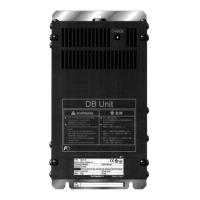2.2 Wiring
2-39
INSTALLATION AND WIRING
Chap 2
In emergencies such as when the inverter protective function is activated, disconnecting the inverter from
the power source to prevent magnification of failure or accident may be desired. Installation of an MC
which allows manual disconnection of the power source is recommended.
(2) Inverter output terminals U, V, W, motor ground terminal
G
1) Connect the Three-phase motor terminals U, V, and W while matching the phase sequence.
2) Connect the ground line of the outputs (U, V, W) to the ground terminal (
z
G).
When multiple combinations of inverters and motors exist, do not use multi-core cables for the purpose of
bundling the various wires.
(3) Direct current reactor connection terminals P1, P(+)
Connect the direct current reactor (DCR) for power factor enhancement.
1) Remove the shorting bar from terminals P1-P(+).
(Types FRN0203E2■-4 or above will not have the shorting bar connected.)
2) Connect the P1, P(+) terminals to the direct current reactor (option).
Keep the wiring length below 10 meters.
Do not remove the shorting bar if the direct current reactor is not used.
When the capacity of the motor to be used is above 75 kW, always connect the direct current reactor.
Direct current reactors do not have to be connected when connecting PWM converters.
Always connect the direct current reactor (option) when the power supply transformer capacity is above 500 kVA
and is over 10 times the rated capacity of the inverter.
Risk of fire exists.
(4) Braking resistor connection terminals P(+) DB
(Types FRN0115E2
or below)
1) Connect terminals P(+), DB of the inverter to braking resistor terminals (option).
2) Mount the inverter main body and the braking resistor such that the wiring length will be less than 5m (16ft)
and route the two wires twisted or in contact with each other (parallel).
Do not connect to terminals other than P(+)-DB when connecting braking resistors.

